MGT5MOC: Organisational Development Action Plan for Matra University
VerifiedAdded on 2022/10/11
|11
|3163
|19
Report
AI Summary
This report presents an Organizational Development (OD) action plan created by the Bundoora Consulting Group for Matra University, addressing issues like employee dissatisfaction, poor mental health, and lack of strategic vision. The plan, sponsored by the new Director of OD, aims to enhance employee engagement, productivity, and organizational performance. It includes a detailed analysis of project objectives, change principles, ethical considerations, and the rationale for change, highlighting the importance of communication and employee involvement. The report outlines key change elements such as resource planning, employee training, implementation, and review, alongside a stakeholder analysis considering staff, students, and management. It emphasizes the importance of assessing readiness to change and delivering key messages to stakeholders. The plan incorporates elements of Lewin's change management theory and Kotter’s change management model to ensure a smooth transition and sustainable change. The report also addresses potential constraints, risks, and the need for a competent change team to facilitate the OD action plan's successful implementation. Finally, the report details the change plan's execution, review, and modification stages, emphasizing the importance of stakeholder feedback and adaptation to achieve the desired outcomes.
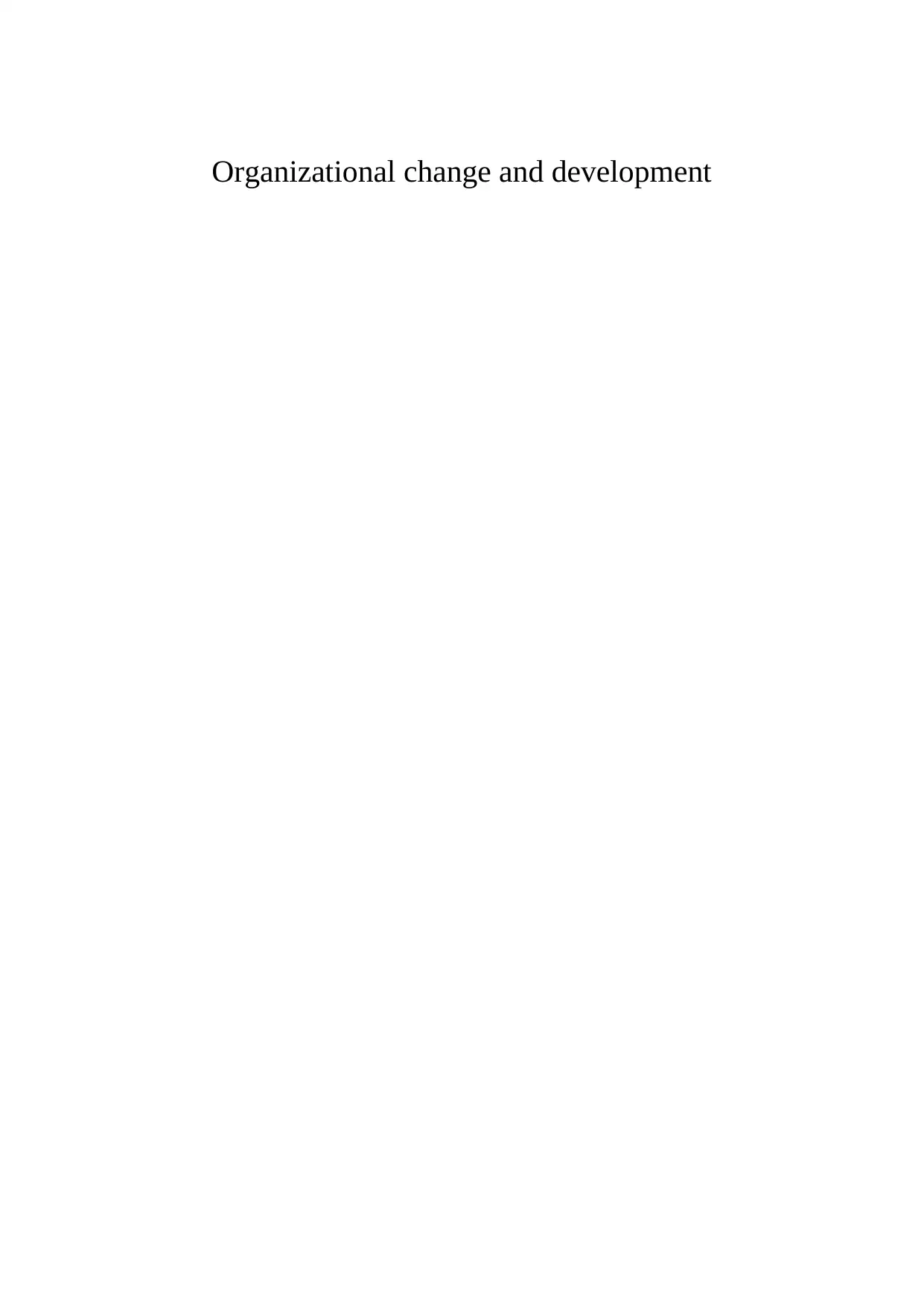
Organizational change and development
Paraphrase This Document
Need a fresh take? Get an instant paraphrase of this document with our AI Paraphraser
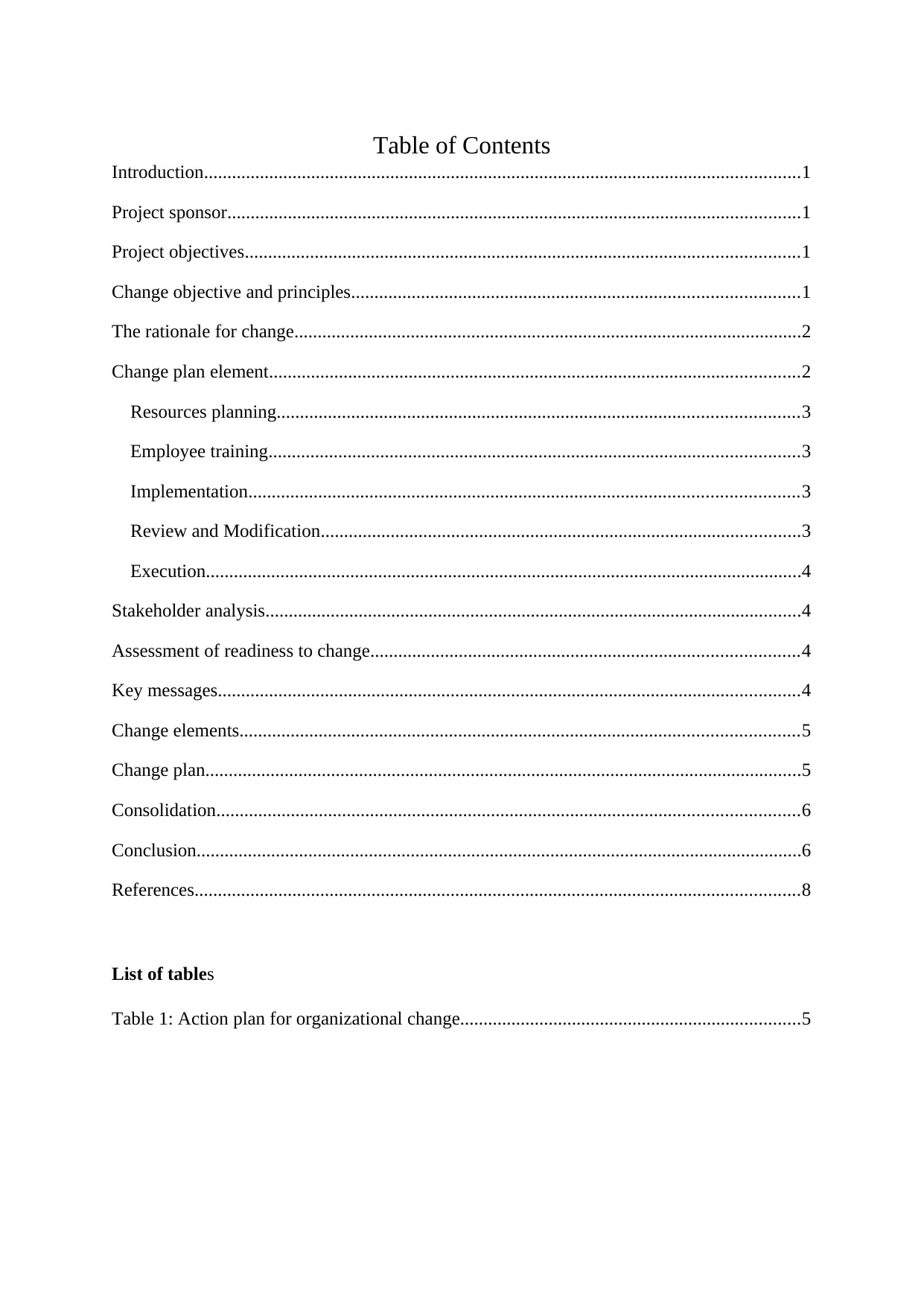
Table of Contents
Introduction................................................................................................................................1
Project sponsor...........................................................................................................................1
Project objectives.......................................................................................................................1
Change objective and principles................................................................................................1
The rationale for change.............................................................................................................2
Change plan element..................................................................................................................2
Resources planning................................................................................................................3
Employee training..................................................................................................................3
Implementation......................................................................................................................3
Review and Modification.......................................................................................................3
Execution................................................................................................................................4
Stakeholder analysis...................................................................................................................4
Assessment of readiness to change............................................................................................4
Key messages.............................................................................................................................4
Change elements........................................................................................................................5
Change plan................................................................................................................................5
Consolidation.............................................................................................................................6
Conclusion..................................................................................................................................6
References..................................................................................................................................8
List of tables
Table 1: Action plan for organizational change.........................................................................5
Introduction................................................................................................................................1
Project sponsor...........................................................................................................................1
Project objectives.......................................................................................................................1
Change objective and principles................................................................................................1
The rationale for change.............................................................................................................2
Change plan element..................................................................................................................2
Resources planning................................................................................................................3
Employee training..................................................................................................................3
Implementation......................................................................................................................3
Review and Modification.......................................................................................................3
Execution................................................................................................................................4
Stakeholder analysis...................................................................................................................4
Assessment of readiness to change............................................................................................4
Key messages.............................................................................................................................4
Change elements........................................................................................................................5
Change plan................................................................................................................................5
Consolidation.............................................................................................................................6
Conclusion..................................................................................................................................6
References..................................................................................................................................8
List of tables
Table 1: Action plan for organizational change.........................................................................5
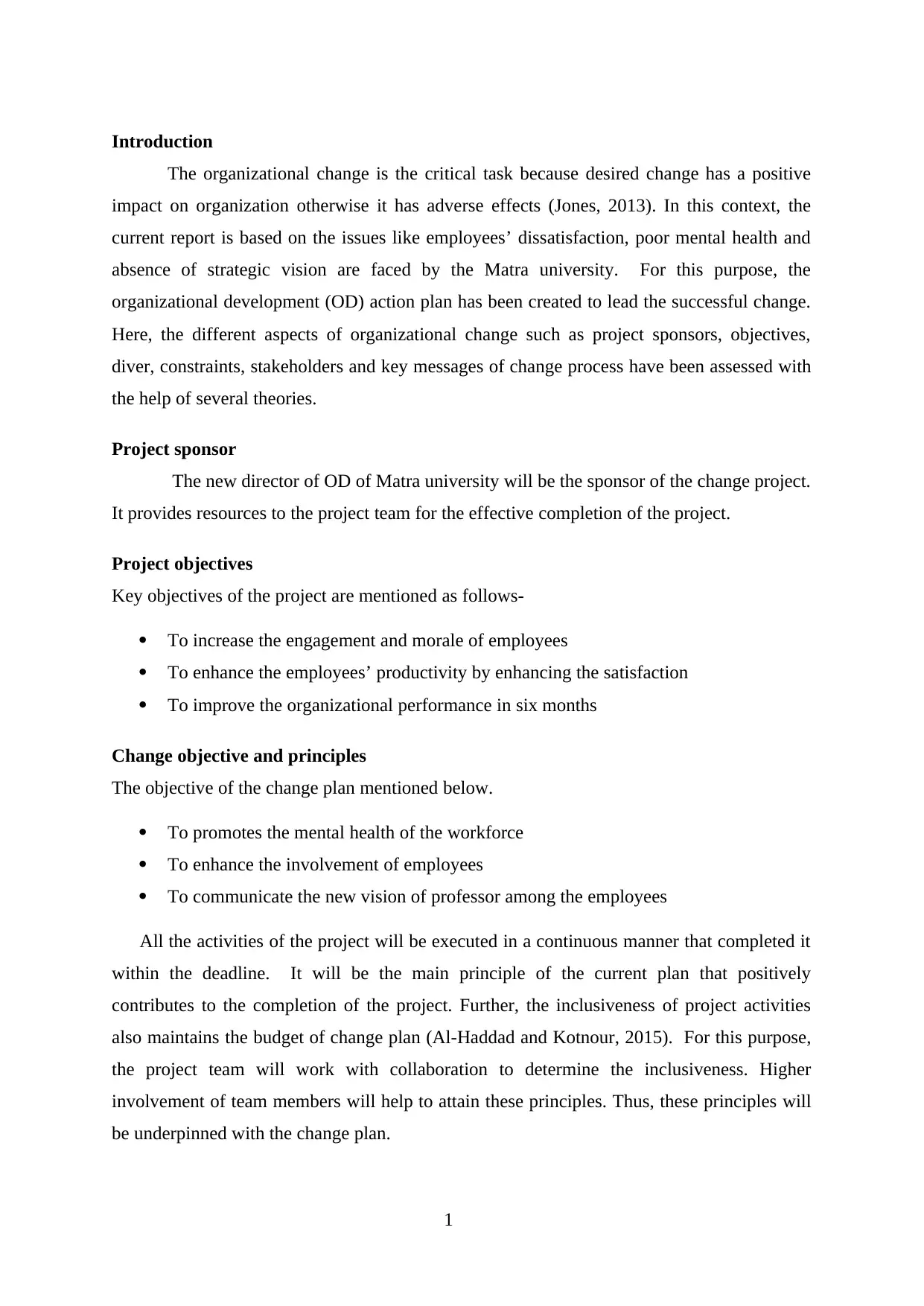
Introduction
The organizational change is the critical task because desired change has a positive
impact on organization otherwise it has adverse effects (Jones, 2013). In this context, the
current report is based on the issues like employees’ dissatisfaction, poor mental health and
absence of strategic vision are faced by the Matra university. For this purpose, the
organizational development (OD) action plan has been created to lead the successful change.
Here, the different aspects of organizational change such as project sponsors, objectives,
diver, constraints, stakeholders and key messages of change process have been assessed with
the help of several theories.
Project sponsor
The new director of OD of Matra university will be the sponsor of the change project.
It provides resources to the project team for the effective completion of the project.
Project objectives
Key objectives of the project are mentioned as follows-
To increase the engagement and morale of employees
To enhance the employees’ productivity by enhancing the satisfaction
To improve the organizational performance in six months
Change objective and principles
The objective of the change plan mentioned below.
To promotes the mental health of the workforce
To enhance the involvement of employees
To communicate the new vision of professor among the employees
All the activities of the project will be executed in a continuous manner that completed it
within the deadline. It will be the main principle of the current plan that positively
contributes to the completion of the project. Further, the inclusiveness of project activities
also maintains the budget of change plan (Al-Haddad and Kotnour, 2015). For this purpose,
the project team will work with collaboration to determine the inclusiveness. Higher
involvement of team members will help to attain these principles. Thus, these principles will
be underpinned with the change plan.
1
The organizational change is the critical task because desired change has a positive
impact on organization otherwise it has adverse effects (Jones, 2013). In this context, the
current report is based on the issues like employees’ dissatisfaction, poor mental health and
absence of strategic vision are faced by the Matra university. For this purpose, the
organizational development (OD) action plan has been created to lead the successful change.
Here, the different aspects of organizational change such as project sponsors, objectives,
diver, constraints, stakeholders and key messages of change process have been assessed with
the help of several theories.
Project sponsor
The new director of OD of Matra university will be the sponsor of the change project.
It provides resources to the project team for the effective completion of the project.
Project objectives
Key objectives of the project are mentioned as follows-
To increase the engagement and morale of employees
To enhance the employees’ productivity by enhancing the satisfaction
To improve the organizational performance in six months
Change objective and principles
The objective of the change plan mentioned below.
To promotes the mental health of the workforce
To enhance the involvement of employees
To communicate the new vision of professor among the employees
All the activities of the project will be executed in a continuous manner that completed it
within the deadline. It will be the main principle of the current plan that positively
contributes to the completion of the project. Further, the inclusiveness of project activities
also maintains the budget of change plan (Al-Haddad and Kotnour, 2015). For this purpose,
the project team will work with collaboration to determine the inclusiveness. Higher
involvement of team members will help to attain these principles. Thus, these principles will
be underpinned with the change plan.
1
⊘ This is a preview!⊘
Do you want full access?
Subscribe today to unlock all pages.

Trusted by 1+ million students worldwide
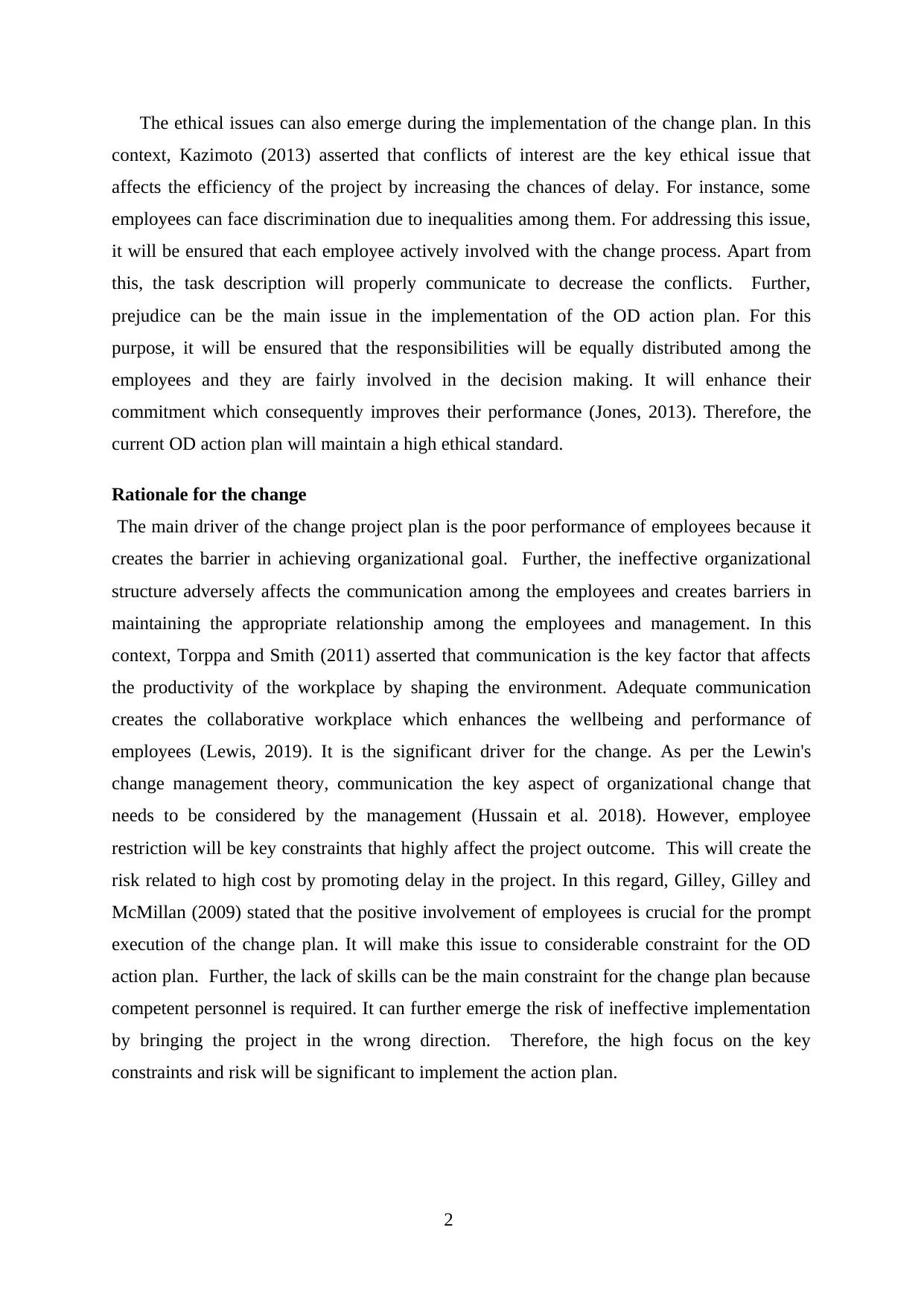
The ethical issues can also emerge during the implementation of the change plan. In this
context, Kazimoto (2013) asserted that conflicts of interest are the key ethical issue that
affects the efficiency of the project by increasing the chances of delay. For instance, some
employees can face discrimination due to inequalities among them. For addressing this issue,
it will be ensured that each employee actively involved with the change process. Apart from
this, the task description will properly communicate to decrease the conflicts. Further,
prejudice can be the main issue in the implementation of the OD action plan. For this
purpose, it will be ensured that the responsibilities will be equally distributed among the
employees and they are fairly involved in the decision making. It will enhance their
commitment which consequently improves their performance (Jones, 2013). Therefore, the
current OD action plan will maintain a high ethical standard.
Rationale for the change
The main driver of the change project plan is the poor performance of employees because it
creates the barrier in achieving organizational goal. Further, the ineffective organizational
structure adversely affects the communication among the employees and creates barriers in
maintaining the appropriate relationship among the employees and management. In this
context, Torppa and Smith (2011) asserted that communication is the key factor that affects
the productivity of the workplace by shaping the environment. Adequate communication
creates the collaborative workplace which enhances the wellbeing and performance of
employees (Lewis, 2019). It is the significant driver for the change. As per the Lewin's
change management theory, communication the key aspect of organizational change that
needs to be considered by the management (Hussain et al. 2018). However, employee
restriction will be key constraints that highly affect the project outcome. This will create the
risk related to high cost by promoting delay in the project. In this regard, Gilley, Gilley and
McMillan (2009) stated that the positive involvement of employees is crucial for the prompt
execution of the change plan. It will make this issue to considerable constraint for the OD
action plan. Further, the lack of skills can be the main constraint for the change plan because
competent personnel is required. It can further emerge the risk of ineffective implementation
by bringing the project in the wrong direction. Therefore, the high focus on the key
constraints and risk will be significant to implement the action plan.
2
context, Kazimoto (2013) asserted that conflicts of interest are the key ethical issue that
affects the efficiency of the project by increasing the chances of delay. For instance, some
employees can face discrimination due to inequalities among them. For addressing this issue,
it will be ensured that each employee actively involved with the change process. Apart from
this, the task description will properly communicate to decrease the conflicts. Further,
prejudice can be the main issue in the implementation of the OD action plan. For this
purpose, it will be ensured that the responsibilities will be equally distributed among the
employees and they are fairly involved in the decision making. It will enhance their
commitment which consequently improves their performance (Jones, 2013). Therefore, the
current OD action plan will maintain a high ethical standard.
Rationale for the change
The main driver of the change project plan is the poor performance of employees because it
creates the barrier in achieving organizational goal. Further, the ineffective organizational
structure adversely affects the communication among the employees and creates barriers in
maintaining the appropriate relationship among the employees and management. In this
context, Torppa and Smith (2011) asserted that communication is the key factor that affects
the productivity of the workplace by shaping the environment. Adequate communication
creates the collaborative workplace which enhances the wellbeing and performance of
employees (Lewis, 2019). It is the significant driver for the change. As per the Lewin's
change management theory, communication the key aspect of organizational change that
needs to be considered by the management (Hussain et al. 2018). However, employee
restriction will be key constraints that highly affect the project outcome. This will create the
risk related to high cost by promoting delay in the project. In this regard, Gilley, Gilley and
McMillan (2009) stated that the positive involvement of employees is crucial for the prompt
execution of the change plan. It will make this issue to considerable constraint for the OD
action plan. Further, the lack of skills can be the main constraint for the change plan because
competent personnel is required. It can further emerge the risk of ineffective implementation
by bringing the project in the wrong direction. Therefore, the high focus on the key
constraints and risk will be significant to implement the action plan.
2
Paraphrase This Document
Need a fresh take? Get an instant paraphrase of this document with our AI Paraphraser
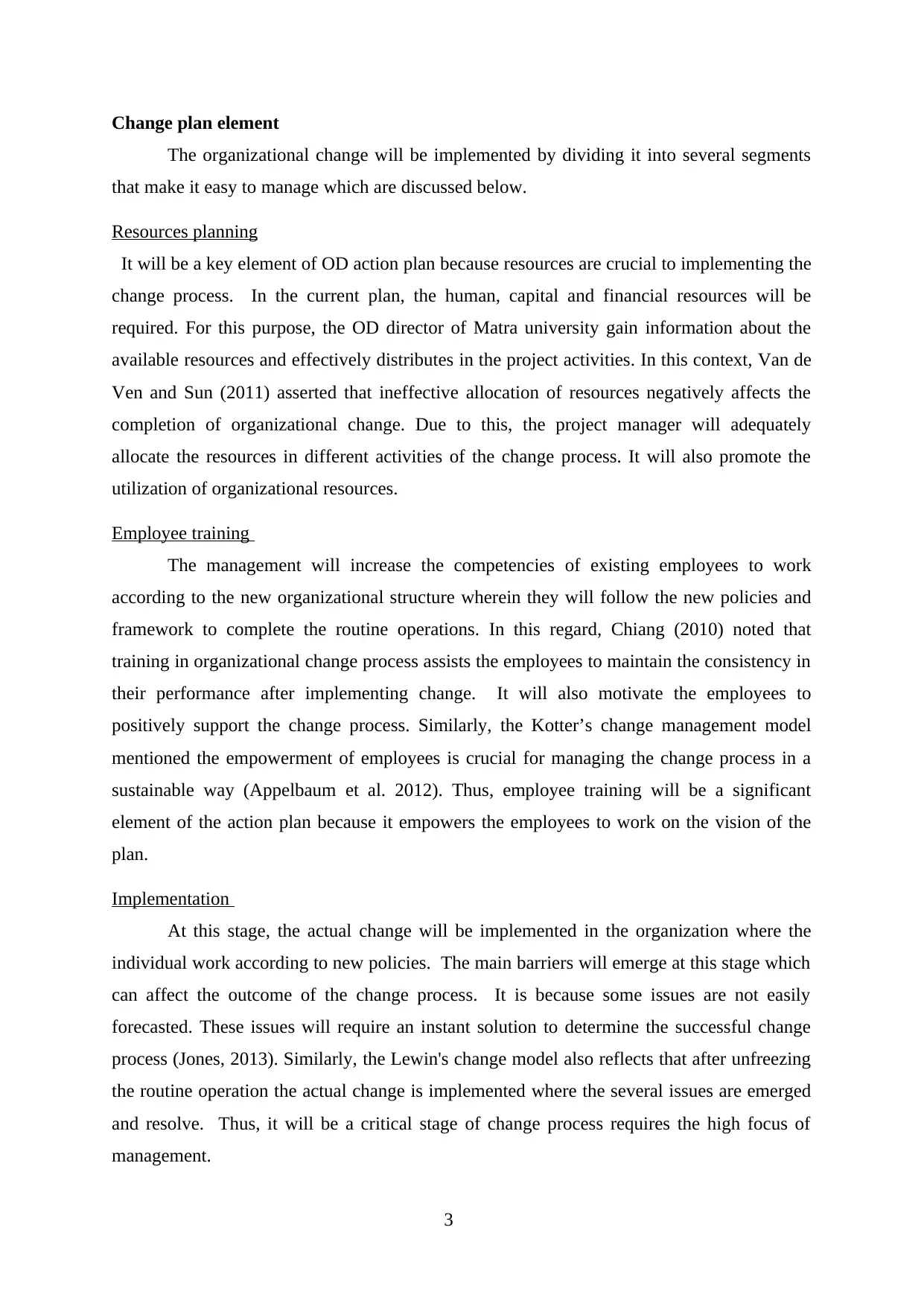
Change plan element
The organizational change will be implemented by dividing it into several segments
that make it easy to manage which are discussed below.
Resources planning
It will be a key element of OD action plan because resources are crucial to implementing the
change process. In the current plan, the human, capital and financial resources will be
required. For this purpose, the OD director of Matra university gain information about the
available resources and effectively distributes in the project activities. In this context, Van de
Ven and Sun (2011) asserted that ineffective allocation of resources negatively affects the
completion of organizational change. Due to this, the project manager will adequately
allocate the resources in different activities of the change process. It will also promote the
utilization of organizational resources.
Employee training
The management will increase the competencies of existing employees to work
according to the new organizational structure wherein they will follow the new policies and
framework to complete the routine operations. In this regard, Chiang (2010) noted that
training in organizational change process assists the employees to maintain the consistency in
their performance after implementing change. It will also motivate the employees to
positively support the change process. Similarly, the Kotter’s change management model
mentioned the empowerment of employees is crucial for managing the change process in a
sustainable way (Appelbaum et al. 2012). Thus, employee training will be a significant
element of the action plan because it empowers the employees to work on the vision of the
plan.
Implementation
At this stage, the actual change will be implemented in the organization where the
individual work according to new policies. The main barriers will emerge at this stage which
can affect the outcome of the change process. It is because some issues are not easily
forecasted. These issues will require an instant solution to determine the successful change
process (Jones, 2013). Similarly, the Lewin's change model also reflects that after unfreezing
the routine operation the actual change is implemented where the several issues are emerged
and resolve. Thus, it will be a critical stage of change process requires the high focus of
management.
3
The organizational change will be implemented by dividing it into several segments
that make it easy to manage which are discussed below.
Resources planning
It will be a key element of OD action plan because resources are crucial to implementing the
change process. In the current plan, the human, capital and financial resources will be
required. For this purpose, the OD director of Matra university gain information about the
available resources and effectively distributes in the project activities. In this context, Van de
Ven and Sun (2011) asserted that ineffective allocation of resources negatively affects the
completion of organizational change. Due to this, the project manager will adequately
allocate the resources in different activities of the change process. It will also promote the
utilization of organizational resources.
Employee training
The management will increase the competencies of existing employees to work
according to the new organizational structure wherein they will follow the new policies and
framework to complete the routine operations. In this regard, Chiang (2010) noted that
training in organizational change process assists the employees to maintain the consistency in
their performance after implementing change. It will also motivate the employees to
positively support the change process. Similarly, the Kotter’s change management model
mentioned the empowerment of employees is crucial for managing the change process in a
sustainable way (Appelbaum et al. 2012). Thus, employee training will be a significant
element of the action plan because it empowers the employees to work on the vision of the
plan.
Implementation
At this stage, the actual change will be implemented in the organization where the
individual work according to new policies. The main barriers will emerge at this stage which
can affect the outcome of the change process. It is because some issues are not easily
forecasted. These issues will require an instant solution to determine the successful change
process (Jones, 2013). Similarly, the Lewin's change model also reflects that after unfreezing
the routine operation the actual change is implemented where the several issues are emerged
and resolve. Thus, it will be a critical stage of change process requires the high focus of
management.
3
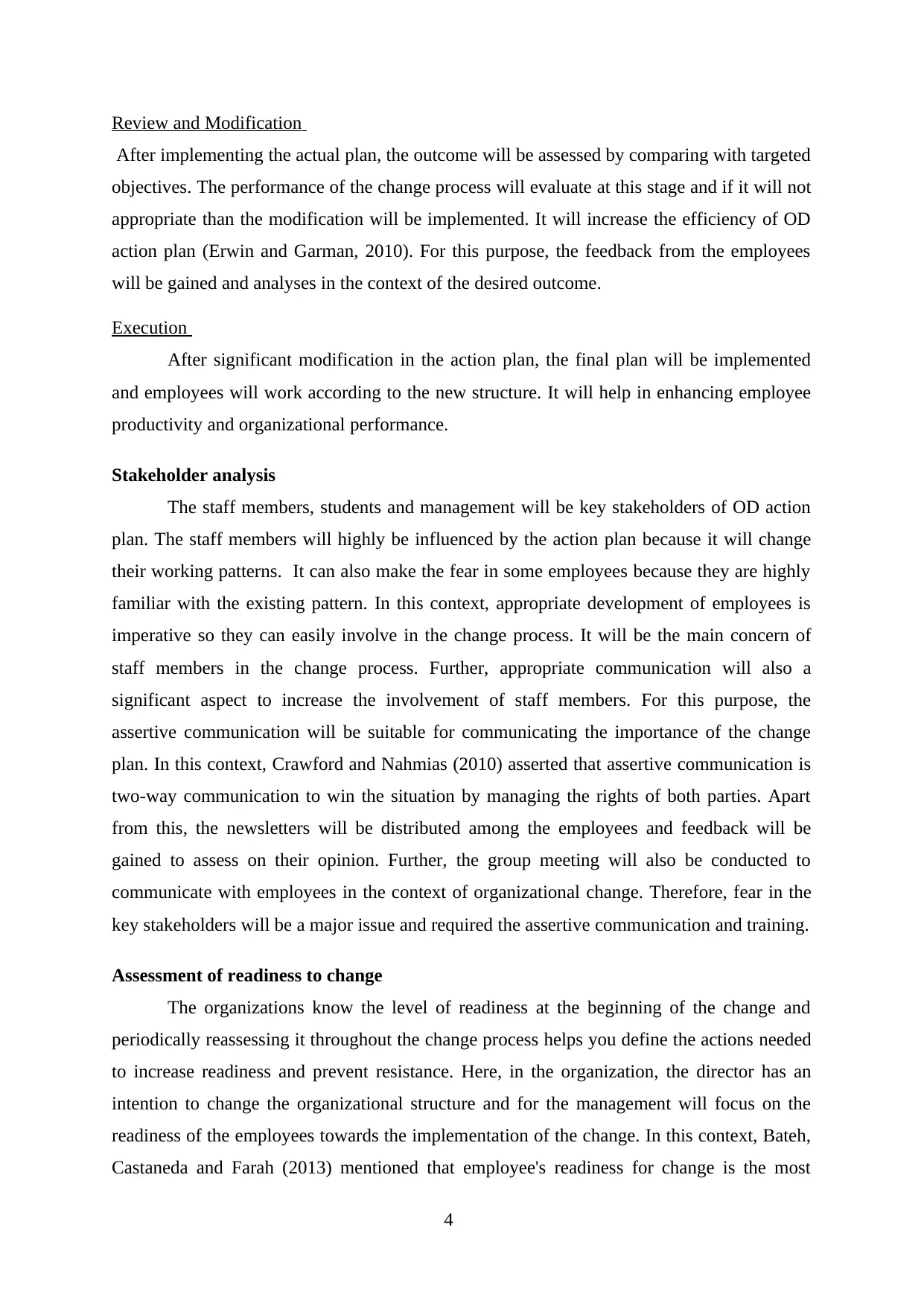
Review and Modification
After implementing the actual plan, the outcome will be assessed by comparing with targeted
objectives. The performance of the change process will evaluate at this stage and if it will not
appropriate than the modification will be implemented. It will increase the efficiency of OD
action plan (Erwin and Garman, 2010). For this purpose, the feedback from the employees
will be gained and analyses in the context of the desired outcome.
Execution
After significant modification in the action plan, the final plan will be implemented
and employees will work according to the new structure. It will help in enhancing employee
productivity and organizational performance.
Stakeholder analysis
The staff members, students and management will be key stakeholders of OD action
plan. The staff members will highly be influenced by the action plan because it will change
their working patterns. It can also make the fear in some employees because they are highly
familiar with the existing pattern. In this context, appropriate development of employees is
imperative so they can easily involve in the change process. It will be the main concern of
staff members in the change process. Further, appropriate communication will also a
significant aspect to increase the involvement of staff members. For this purpose, the
assertive communication will be suitable for communicating the importance of the change
plan. In this context, Crawford and Nahmias (2010) asserted that assertive communication is
two-way communication to win the situation by managing the rights of both parties. Apart
from this, the newsletters will be distributed among the employees and feedback will be
gained to assess on their opinion. Further, the group meeting will also be conducted to
communicate with employees in the context of organizational change. Therefore, fear in the
key stakeholders will be a major issue and required the assertive communication and training.
Assessment of readiness to change
The organizations know the level of readiness at the beginning of the change and
periodically reassessing it throughout the change process helps you define the actions needed
to increase readiness and prevent resistance. Here, in the organization, the director has an
intention to change the organizational structure and for the management will focus on the
readiness of the employees towards the implementation of the change. In this context, Bateh,
Castaneda and Farah (2013) mentioned that employee's readiness for change is the most
4
After implementing the actual plan, the outcome will be assessed by comparing with targeted
objectives. The performance of the change process will evaluate at this stage and if it will not
appropriate than the modification will be implemented. It will increase the efficiency of OD
action plan (Erwin and Garman, 2010). For this purpose, the feedback from the employees
will be gained and analyses in the context of the desired outcome.
Execution
After significant modification in the action plan, the final plan will be implemented
and employees will work according to the new structure. It will help in enhancing employee
productivity and organizational performance.
Stakeholder analysis
The staff members, students and management will be key stakeholders of OD action
plan. The staff members will highly be influenced by the action plan because it will change
their working patterns. It can also make the fear in some employees because they are highly
familiar with the existing pattern. In this context, appropriate development of employees is
imperative so they can easily involve in the change process. It will be the main concern of
staff members in the change process. Further, appropriate communication will also a
significant aspect to increase the involvement of staff members. For this purpose, the
assertive communication will be suitable for communicating the importance of the change
plan. In this context, Crawford and Nahmias (2010) asserted that assertive communication is
two-way communication to win the situation by managing the rights of both parties. Apart
from this, the newsletters will be distributed among the employees and feedback will be
gained to assess on their opinion. Further, the group meeting will also be conducted to
communicate with employees in the context of organizational change. Therefore, fear in the
key stakeholders will be a major issue and required the assertive communication and training.
Assessment of readiness to change
The organizations know the level of readiness at the beginning of the change and
periodically reassessing it throughout the change process helps you define the actions needed
to increase readiness and prevent resistance. Here, in the organization, the director has an
intention to change the organizational structure and for the management will focus on the
readiness of the employees towards the implementation of the change. In this context, Bateh,
Castaneda and Farah (2013) mentioned that employee's readiness for change is the most
4
⊘ This is a preview!⊘
Do you want full access?
Subscribe today to unlock all pages.

Trusted by 1+ million students worldwide
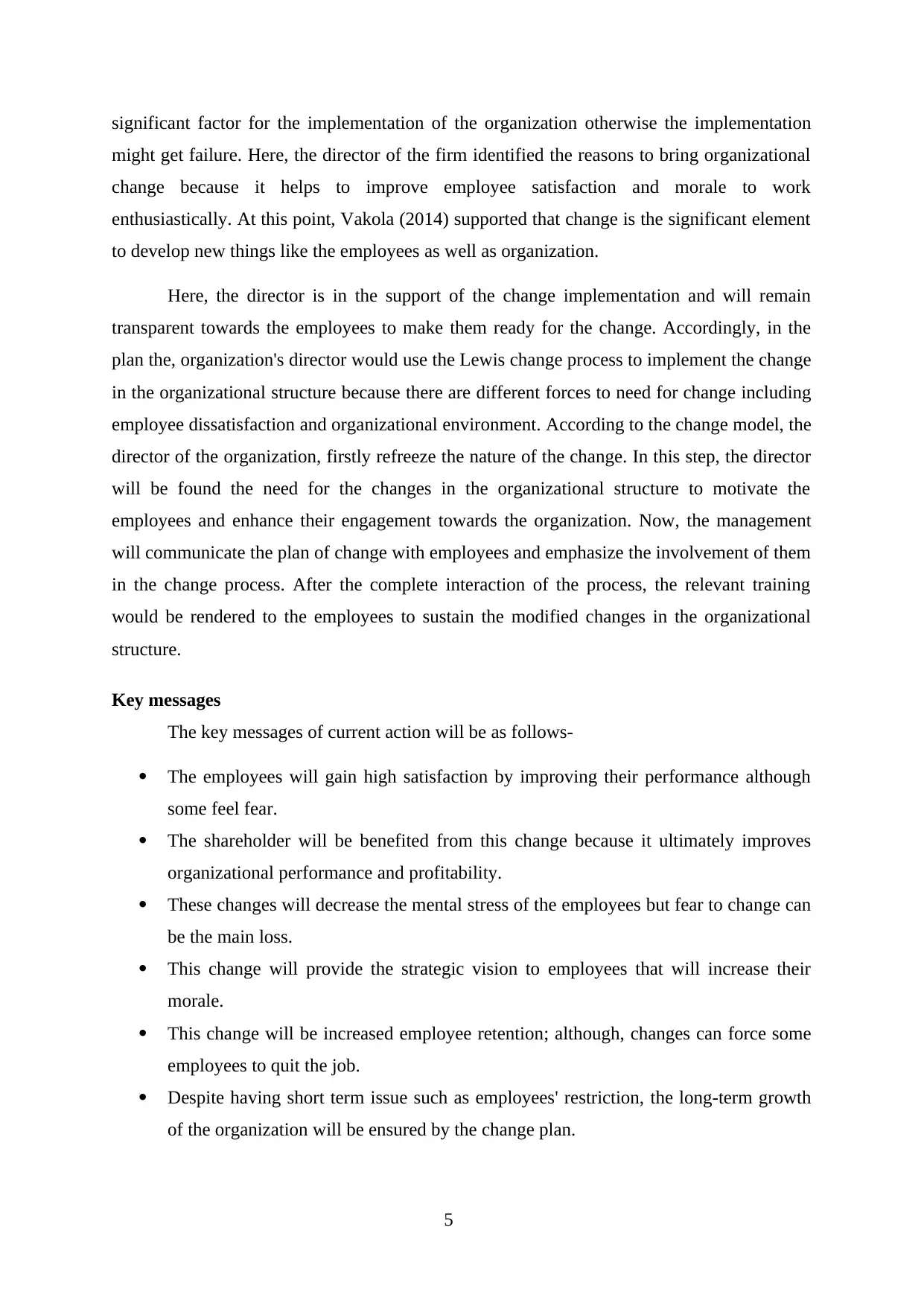
significant factor for the implementation of the organization otherwise the implementation
might get failure. Here, the director of the firm identified the reasons to bring organizational
change because it helps to improve employee satisfaction and morale to work
enthusiastically. At this point, Vakola (2014) supported that change is the significant element
to develop new things like the employees as well as organization.
Here, the director is in the support of the change implementation and will remain
transparent towards the employees to make them ready for the change. Accordingly, in the
plan the, organization's director would use the Lewis change process to implement the change
in the organizational structure because there are different forces to need for change including
employee dissatisfaction and organizational environment. According to the change model, the
director of the organization, firstly refreeze the nature of the change. In this step, the director
will be found the need for the changes in the organizational structure to motivate the
employees and enhance their engagement towards the organization. Now, the management
will communicate the plan of change with employees and emphasize the involvement of them
in the change process. After the complete interaction of the process, the relevant training
would be rendered to the employees to sustain the modified changes in the organizational
structure.
Key messages
The key messages of current action will be as follows-
The employees will gain high satisfaction by improving their performance although
some feel fear.
The shareholder will be benefited from this change because it ultimately improves
organizational performance and profitability.
These changes will decrease the mental stress of the employees but fear to change can
be the main loss.
This change will provide the strategic vision to employees that will increase their
morale.
This change will be increased employee retention; although, changes can force some
employees to quit the job.
Despite having short term issue such as employees' restriction, the long-term growth
of the organization will be ensured by the change plan.
5
might get failure. Here, the director of the firm identified the reasons to bring organizational
change because it helps to improve employee satisfaction and morale to work
enthusiastically. At this point, Vakola (2014) supported that change is the significant element
to develop new things like the employees as well as organization.
Here, the director is in the support of the change implementation and will remain
transparent towards the employees to make them ready for the change. Accordingly, in the
plan the, organization's director would use the Lewis change process to implement the change
in the organizational structure because there are different forces to need for change including
employee dissatisfaction and organizational environment. According to the change model, the
director of the organization, firstly refreeze the nature of the change. In this step, the director
will be found the need for the changes in the organizational structure to motivate the
employees and enhance their engagement towards the organization. Now, the management
will communicate the plan of change with employees and emphasize the involvement of them
in the change process. After the complete interaction of the process, the relevant training
would be rendered to the employees to sustain the modified changes in the organizational
structure.
Key messages
The key messages of current action will be as follows-
The employees will gain high satisfaction by improving their performance although
some feel fear.
The shareholder will be benefited from this change because it ultimately improves
organizational performance and profitability.
These changes will decrease the mental stress of the employees but fear to change can
be the main loss.
This change will provide the strategic vision to employees that will increase their
morale.
This change will be increased employee retention; although, changes can force some
employees to quit the job.
Despite having short term issue such as employees' restriction, the long-term growth
of the organization will be ensured by the change plan.
5
Paraphrase This Document
Need a fresh take? Get an instant paraphrase of this document with our AI Paraphraser
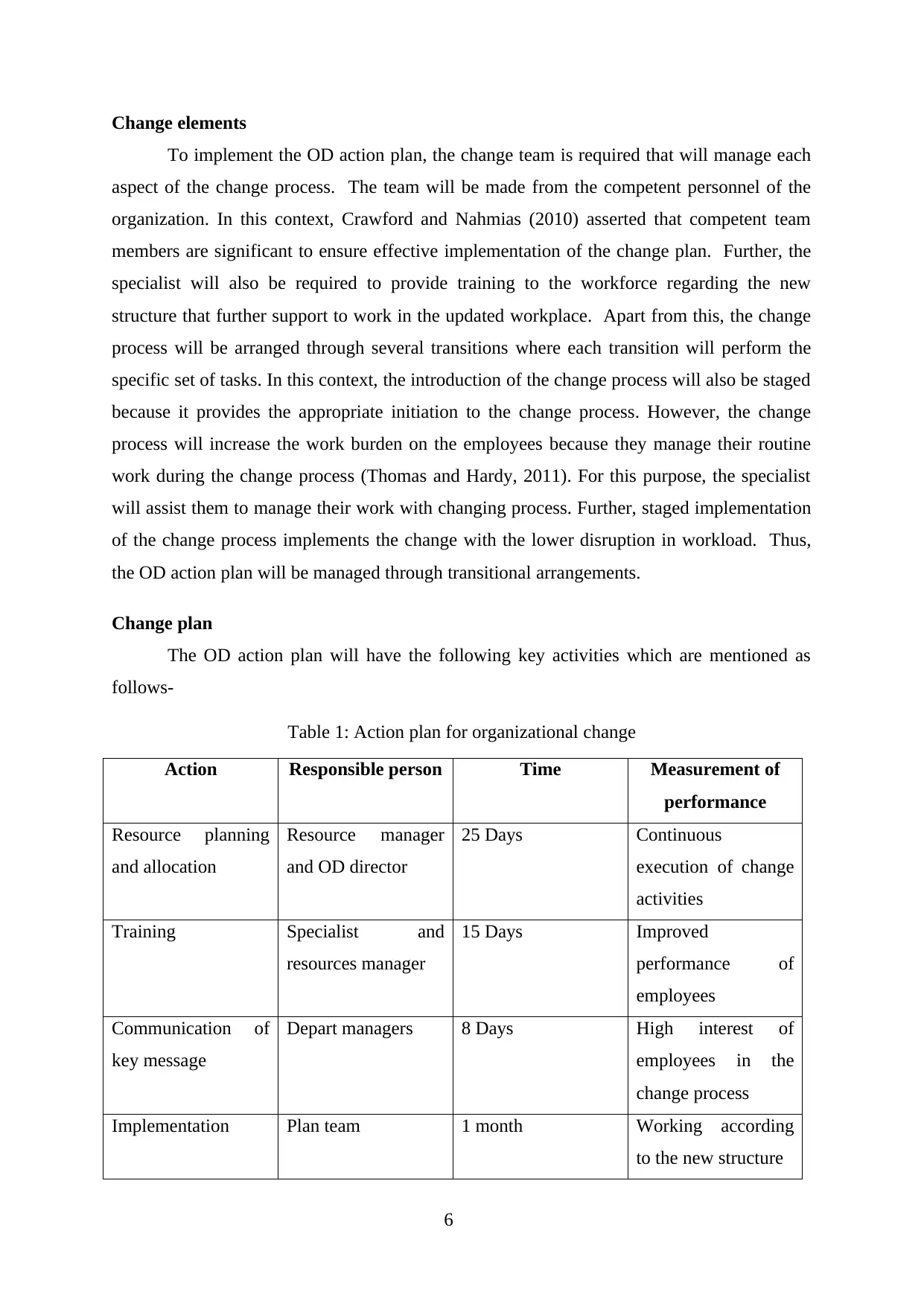
Change elements
To implement the OD action plan, the change team is required that will manage each
aspect of the change process. The team will be made from the competent personnel of the
organization. In this context, Crawford and Nahmias (2010) asserted that competent team
members are significant to ensure effective implementation of the change plan. Further, the
specialist will also be required to provide training to the workforce regarding the new
structure that further support to work in the updated workplace. Apart from this, the change
process will be arranged through several transitions where each transition will perform the
specific set of tasks. In this context, the introduction of the change process will also be staged
because it provides the appropriate initiation to the change process. However, the change
process will increase the work burden on the employees because they manage their routine
work during the change process (Thomas and Hardy, 2011). For this purpose, the specialist
will assist them to manage their work with changing process. Further, staged implementation
of the change process implements the change with the lower disruption in workload. Thus,
the OD action plan will be managed through transitional arrangements.
Change plan
The OD action plan will have the following key activities which are mentioned as
follows-
Table 1: Action plan for organizational change
Action Responsible person Time Measurement of
performance
Resource planning
and allocation
Resource manager
and OD director
25 Days Continuous
execution of change
activities
Training Specialist and
resources manager
15 Days Improved
performance of
employees
Communication of
key message
Depart managers 8 Days High interest of
employees in the
change process
Implementation Plan team 1 month Working according
to the new structure
6
To implement the OD action plan, the change team is required that will manage each
aspect of the change process. The team will be made from the competent personnel of the
organization. In this context, Crawford and Nahmias (2010) asserted that competent team
members are significant to ensure effective implementation of the change plan. Further, the
specialist will also be required to provide training to the workforce regarding the new
structure that further support to work in the updated workplace. Apart from this, the change
process will be arranged through several transitions where each transition will perform the
specific set of tasks. In this context, the introduction of the change process will also be staged
because it provides the appropriate initiation to the change process. However, the change
process will increase the work burden on the employees because they manage their routine
work during the change process (Thomas and Hardy, 2011). For this purpose, the specialist
will assist them to manage their work with changing process. Further, staged implementation
of the change process implements the change with the lower disruption in workload. Thus,
the OD action plan will be managed through transitional arrangements.
Change plan
The OD action plan will have the following key activities which are mentioned as
follows-
Table 1: Action plan for organizational change
Action Responsible person Time Measurement of
performance
Resource planning
and allocation
Resource manager
and OD director
25 Days Continuous
execution of change
activities
Training Specialist and
resources manager
15 Days Improved
performance of
employees
Communication of
key message
Depart managers 8 Days High interest of
employees in the
change process
Implementation Plan team 1 month Working according
to the new structure
6
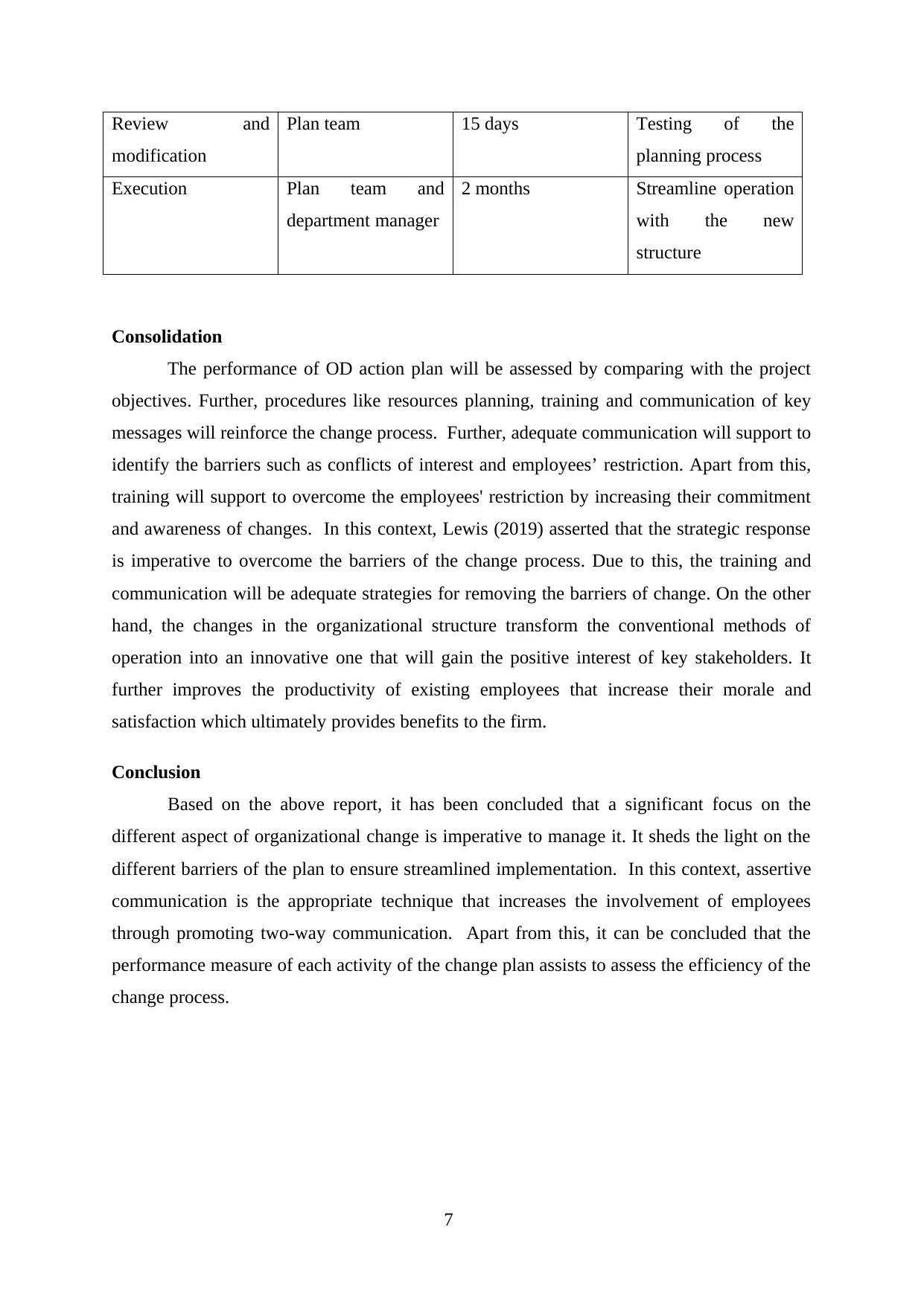
Review and
modification
Plan team 15 days Testing of the
planning process
Execution Plan team and
department manager
2 months Streamline operation
with the new
structure
Consolidation
The performance of OD action plan will be assessed by comparing with the project
objectives. Further, procedures like resources planning, training and communication of key
messages will reinforce the change process. Further, adequate communication will support to
identify the barriers such as conflicts of interest and employees’ restriction. Apart from this,
training will support to overcome the employees' restriction by increasing their commitment
and awareness of changes. In this context, Lewis (2019) asserted that the strategic response
is imperative to overcome the barriers of the change process. Due to this, the training and
communication will be adequate strategies for removing the barriers of change. On the other
hand, the changes in the organizational structure transform the conventional methods of
operation into an innovative one that will gain the positive interest of key stakeholders. It
further improves the productivity of existing employees that increase their morale and
satisfaction which ultimately provides benefits to the firm.
Conclusion
Based on the above report, it has been concluded that a significant focus on the
different aspect of organizational change is imperative to manage it. It sheds the light on the
different barriers of the plan to ensure streamlined implementation. In this context, assertive
communication is the appropriate technique that increases the involvement of employees
through promoting two-way communication. Apart from this, it can be concluded that the
performance measure of each activity of the change plan assists to assess the efficiency of the
change process.
7
modification
Plan team 15 days Testing of the
planning process
Execution Plan team and
department manager
2 months Streamline operation
with the new
structure
Consolidation
The performance of OD action plan will be assessed by comparing with the project
objectives. Further, procedures like resources planning, training and communication of key
messages will reinforce the change process. Further, adequate communication will support to
identify the barriers such as conflicts of interest and employees’ restriction. Apart from this,
training will support to overcome the employees' restriction by increasing their commitment
and awareness of changes. In this context, Lewis (2019) asserted that the strategic response
is imperative to overcome the barriers of the change process. Due to this, the training and
communication will be adequate strategies for removing the barriers of change. On the other
hand, the changes in the organizational structure transform the conventional methods of
operation into an innovative one that will gain the positive interest of key stakeholders. It
further improves the productivity of existing employees that increase their morale and
satisfaction which ultimately provides benefits to the firm.
Conclusion
Based on the above report, it has been concluded that a significant focus on the
different aspect of organizational change is imperative to manage it. It sheds the light on the
different barriers of the plan to ensure streamlined implementation. In this context, assertive
communication is the appropriate technique that increases the involvement of employees
through promoting two-way communication. Apart from this, it can be concluded that the
performance measure of each activity of the change plan assists to assess the efficiency of the
change process.
7
⊘ This is a preview!⊘
Do you want full access?
Subscribe today to unlock all pages.

Trusted by 1+ million students worldwide
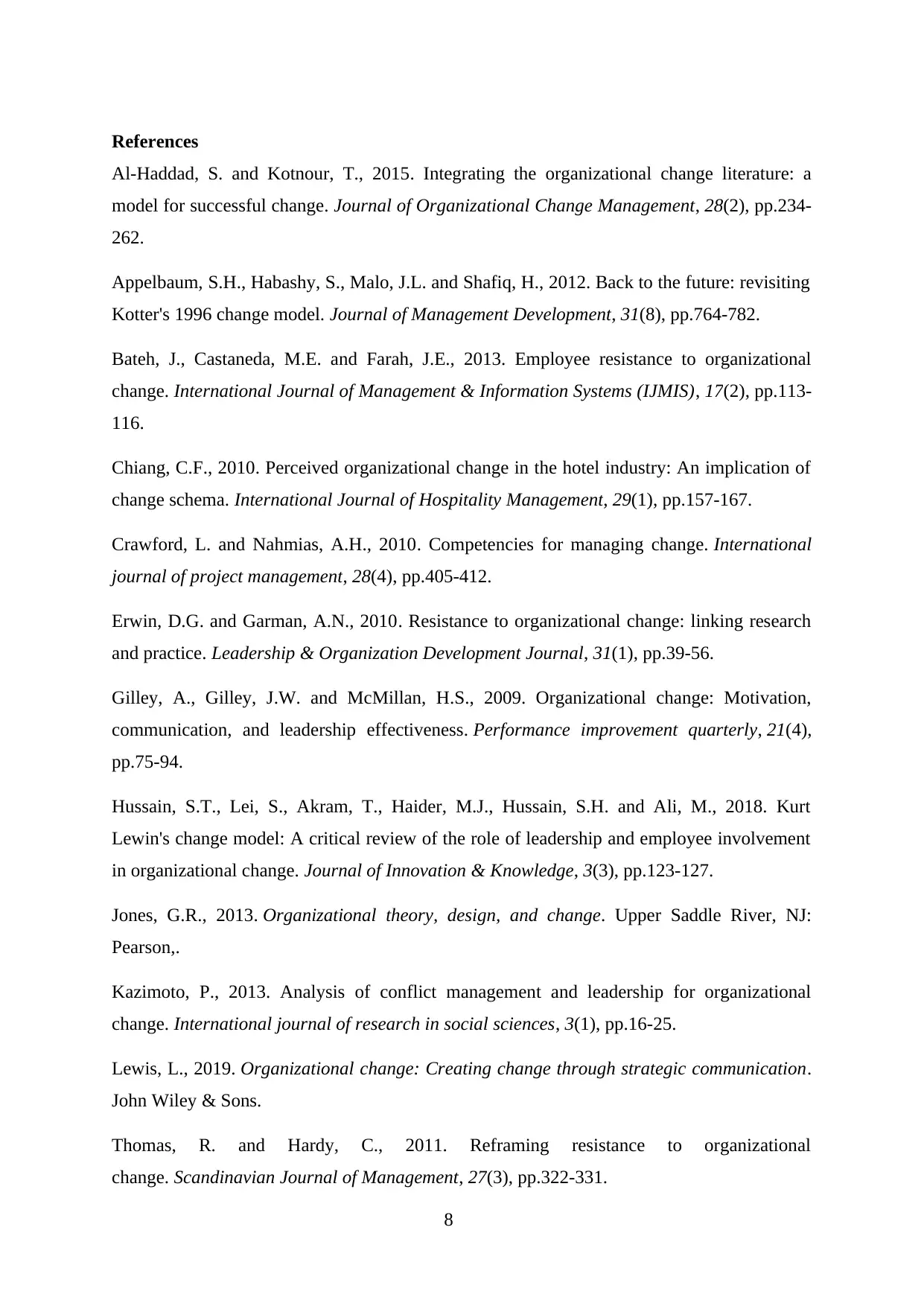
References
Al-Haddad, S. and Kotnour, T., 2015. Integrating the organizational change literature: a
model for successful change. Journal of Organizational Change Management, 28(2), pp.234-
262.
Appelbaum, S.H., Habashy, S., Malo, J.L. and Shafiq, H., 2012. Back to the future: revisiting
Kotter's 1996 change model. Journal of Management Development, 31(8), pp.764-782.
Bateh, J., Castaneda, M.E. and Farah, J.E., 2013. Employee resistance to organizational
change. International Journal of Management & Information Systems (IJMIS), 17(2), pp.113-
116.
Chiang, C.F., 2010. Perceived organizational change in the hotel industry: An implication of
change schema. International Journal of Hospitality Management, 29(1), pp.157-167.
Crawford, L. and Nahmias, A.H., 2010. Competencies for managing change. International
journal of project management, 28(4), pp.405-412.
Erwin, D.G. and Garman, A.N., 2010. Resistance to organizational change: linking research
and practice. Leadership & Organization Development Journal, 31(1), pp.39-56.
Gilley, A., Gilley, J.W. and McMillan, H.S., 2009. Organizational change: Motivation,
communication, and leadership effectiveness. Performance improvement quarterly, 21(4),
pp.75-94.
Hussain, S.T., Lei, S., Akram, T., Haider, M.J., Hussain, S.H. and Ali, M., 2018. Kurt
Lewin's change model: A critical review of the role of leadership and employee involvement
in organizational change. Journal of Innovation & Knowledge, 3(3), pp.123-127.
Jones, G.R., 2013. Organizational theory, design, and change. Upper Saddle River, NJ:
Pearson,.
Kazimoto, P., 2013. Analysis of conflict management and leadership for organizational
change. International journal of research in social sciences, 3(1), pp.16-25.
Lewis, L., 2019. Organizational change: Creating change through strategic communication.
John Wiley & Sons.
Thomas, R. and Hardy, C., 2011. Reframing resistance to organizational
change. Scandinavian Journal of Management, 27(3), pp.322-331.
8
Al-Haddad, S. and Kotnour, T., 2015. Integrating the organizational change literature: a
model for successful change. Journal of Organizational Change Management, 28(2), pp.234-
262.
Appelbaum, S.H., Habashy, S., Malo, J.L. and Shafiq, H., 2012. Back to the future: revisiting
Kotter's 1996 change model. Journal of Management Development, 31(8), pp.764-782.
Bateh, J., Castaneda, M.E. and Farah, J.E., 2013. Employee resistance to organizational
change. International Journal of Management & Information Systems (IJMIS), 17(2), pp.113-
116.
Chiang, C.F., 2010. Perceived organizational change in the hotel industry: An implication of
change schema. International Journal of Hospitality Management, 29(1), pp.157-167.
Crawford, L. and Nahmias, A.H., 2010. Competencies for managing change. International
journal of project management, 28(4), pp.405-412.
Erwin, D.G. and Garman, A.N., 2010. Resistance to organizational change: linking research
and practice. Leadership & Organization Development Journal, 31(1), pp.39-56.
Gilley, A., Gilley, J.W. and McMillan, H.S., 2009. Organizational change: Motivation,
communication, and leadership effectiveness. Performance improvement quarterly, 21(4),
pp.75-94.
Hussain, S.T., Lei, S., Akram, T., Haider, M.J., Hussain, S.H. and Ali, M., 2018. Kurt
Lewin's change model: A critical review of the role of leadership and employee involvement
in organizational change. Journal of Innovation & Knowledge, 3(3), pp.123-127.
Jones, G.R., 2013. Organizational theory, design, and change. Upper Saddle River, NJ:
Pearson,.
Kazimoto, P., 2013. Analysis of conflict management and leadership for organizational
change. International journal of research in social sciences, 3(1), pp.16-25.
Lewis, L., 2019. Organizational change: Creating change through strategic communication.
John Wiley & Sons.
Thomas, R. and Hardy, C., 2011. Reframing resistance to organizational
change. Scandinavian Journal of Management, 27(3), pp.322-331.
8
Paraphrase This Document
Need a fresh take? Get an instant paraphrase of this document with our AI Paraphraser
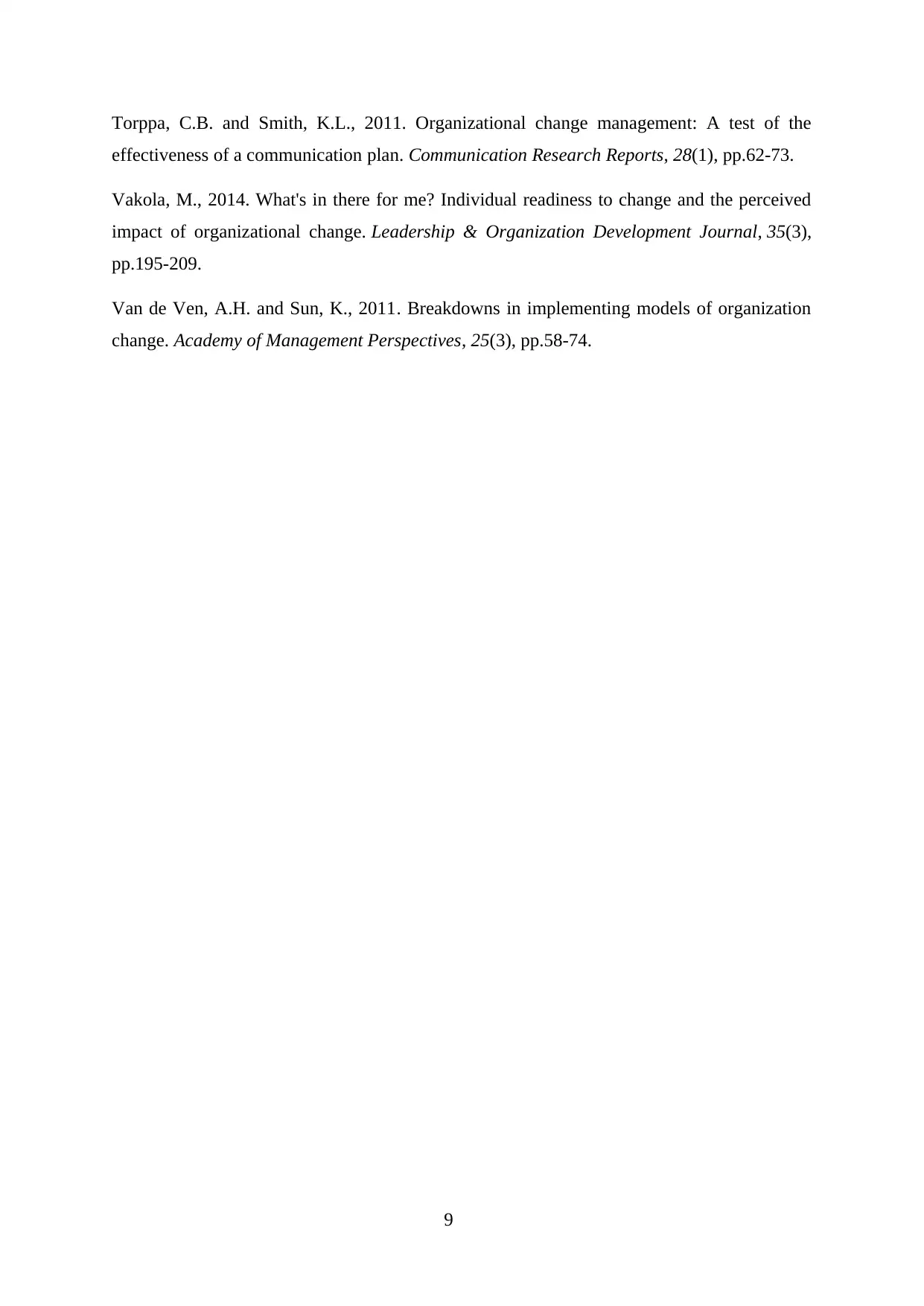
Torppa, C.B. and Smith, K.L., 2011. Organizational change management: A test of the
effectiveness of a communication plan. Communication Research Reports, 28(1), pp.62-73.
Vakola, M., 2014. What's in there for me? Individual readiness to change and the perceived
impact of organizational change. Leadership & Organization Development Journal, 35(3),
pp.195-209.
Van de Ven, A.H. and Sun, K., 2011. Breakdowns in implementing models of organization
change. Academy of Management Perspectives, 25(3), pp.58-74.
9
effectiveness of a communication plan. Communication Research Reports, 28(1), pp.62-73.
Vakola, M., 2014. What's in there for me? Individual readiness to change and the perceived
impact of organizational change. Leadership & Organization Development Journal, 35(3),
pp.195-209.
Van de Ven, A.H. and Sun, K., 2011. Breakdowns in implementing models of organization
change. Academy of Management Perspectives, 25(3), pp.58-74.
9
1 out of 11
Related Documents
Your All-in-One AI-Powered Toolkit for Academic Success.
+13062052269
info@desklib.com
Available 24*7 on WhatsApp / Email
![[object Object]](/_next/static/media/star-bottom.7253800d.svg)
Unlock your academic potential
Copyright © 2020–2025 A2Z Services. All Rights Reserved. Developed and managed by ZUCOL.




